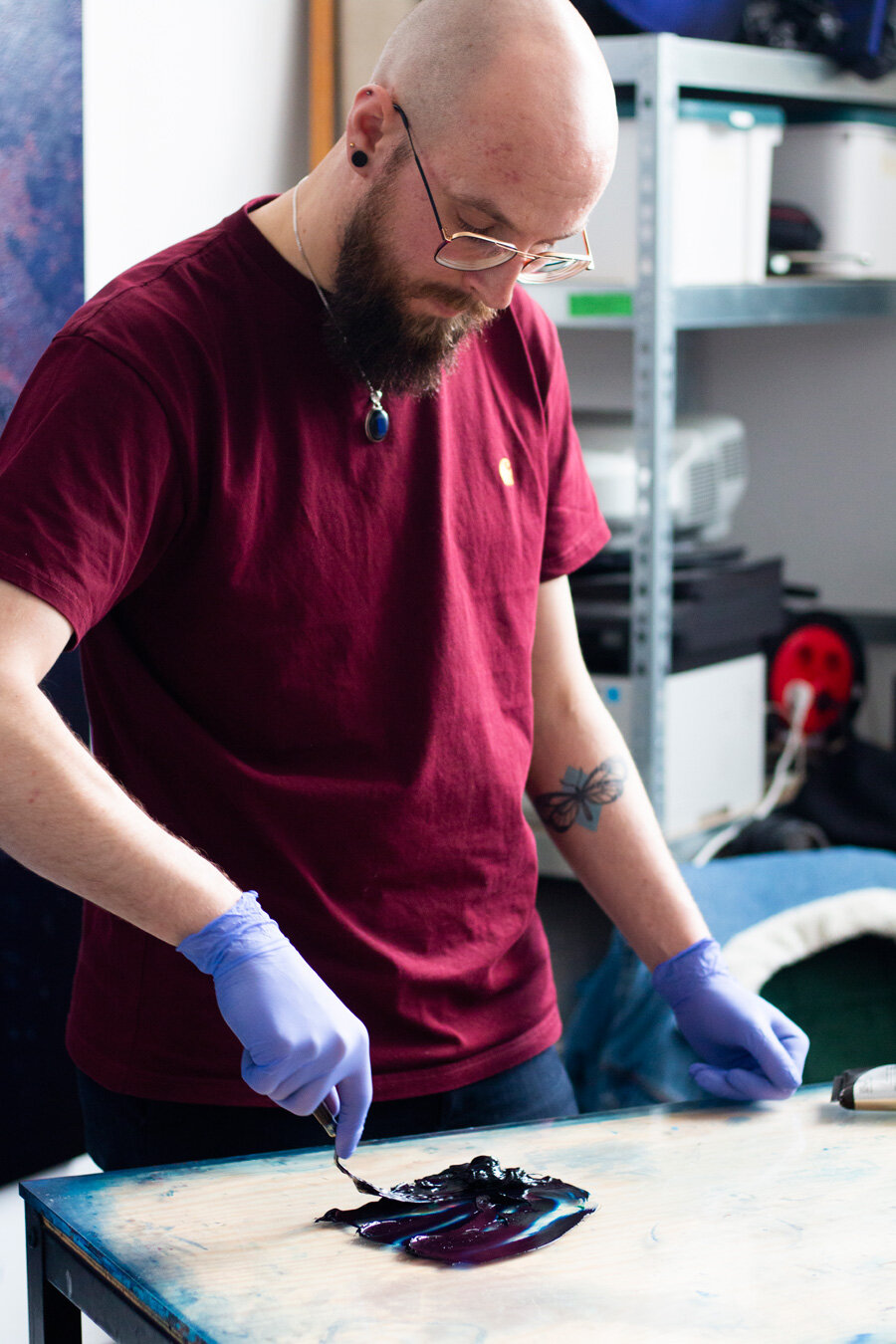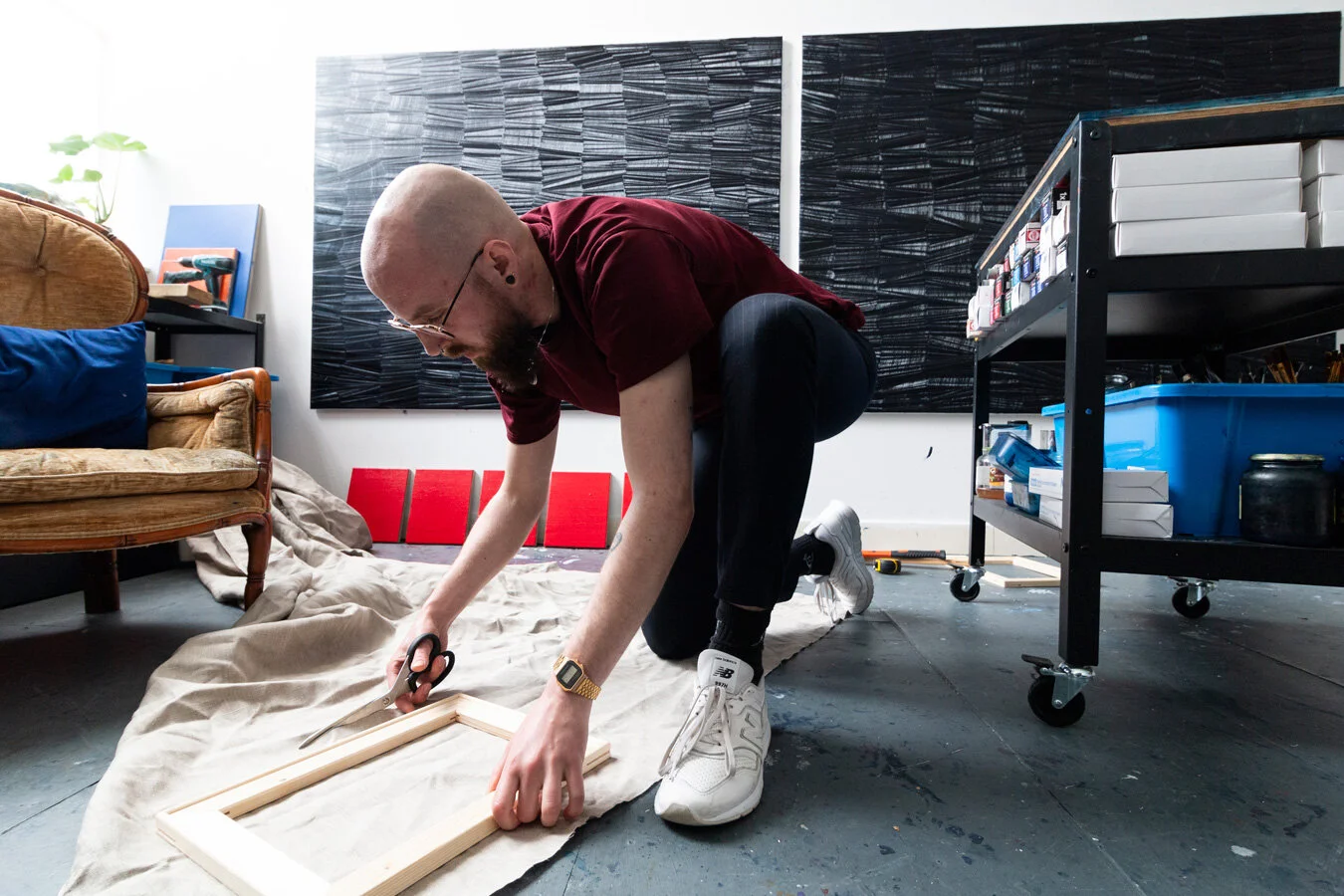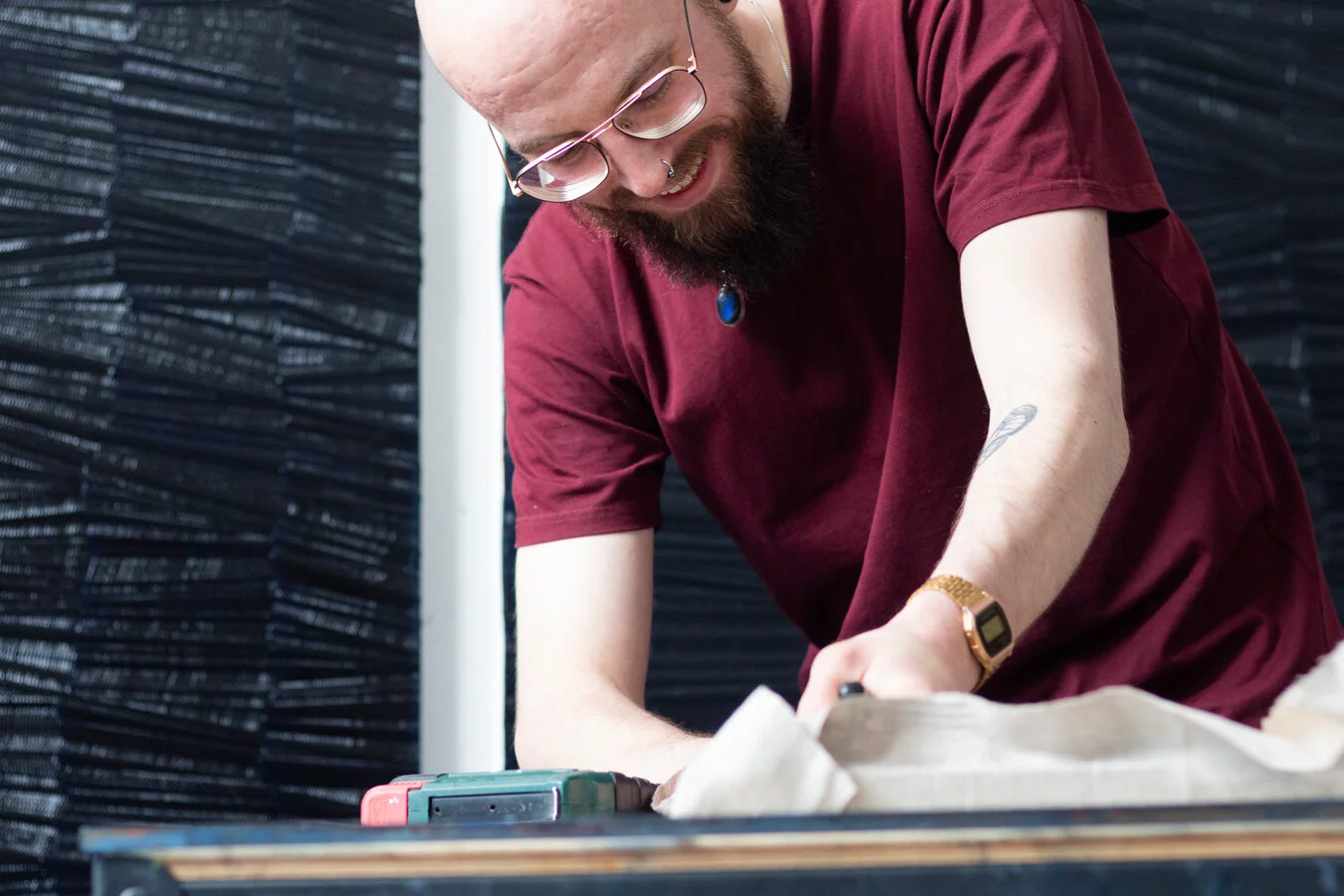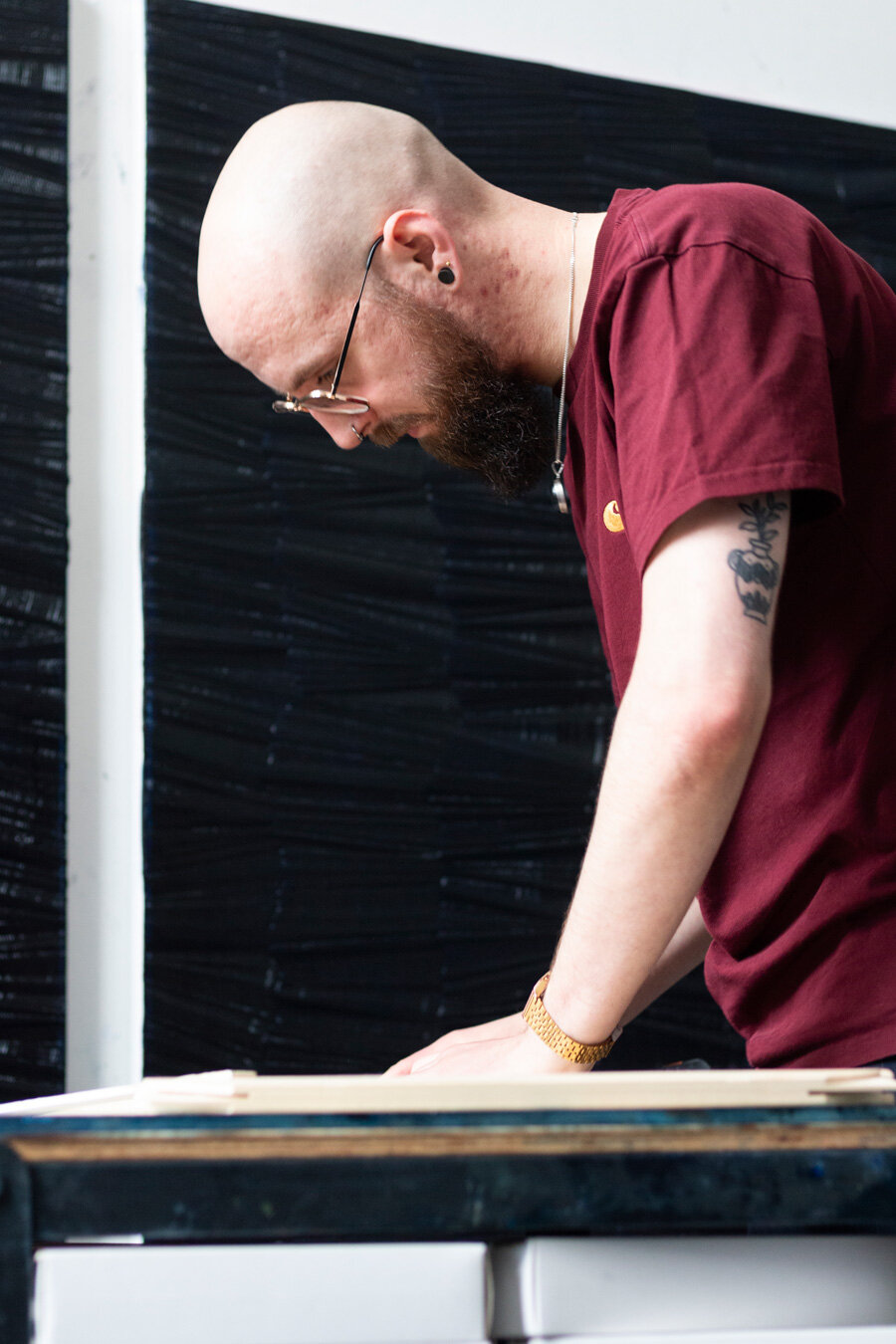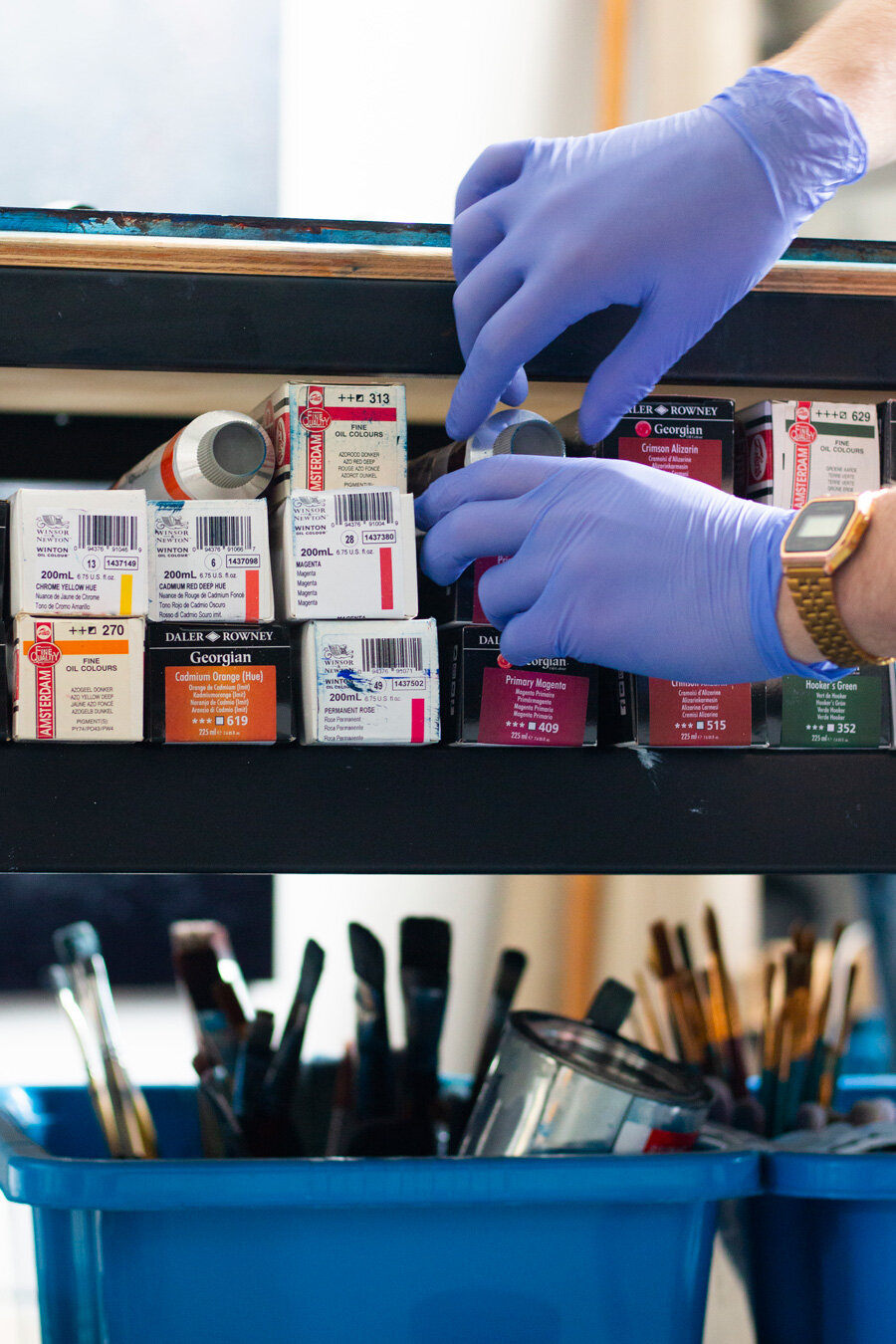A glance into the world of Krijn Kroes (Q&A)
Krijn Kroes has a fascination for the natural world and the effect of light which reflects in his artistic practice. This can be in the form of a pattern of plants and animals, but also in an abstract translation whereby the direction of the brushstroke and the characteristics of the paint play a role in how the light moves across the canvas. He is constantly looking for ways to engage his audience by generating a sense of wonder and curiosity towards the unknown, intending to trigger the imagination of spectators.
His work will be part of a duo exhibition with Jan Kuhlemeier from June 25 until August 14 in the gallery.
“For me, art is exactly the thing that broaches the layer that makes life worth living.”
How did your journey as an artist begin?
Unconsciously, it already started quite a long time ago, but really became concrete later on. I have always drawn and my parents have always stimulated that, but in the past I did not realise that doing something with art would be an option. At the time, I was mostly interested in nature. I grew up in a very small village on the Veluwe, surrounded by an area where there was a lot of nature. The natural world always triggered my fantasy and the place I grew up was a place where my imagination could really run wild. As a child I also really wanted to become a biologist, because my grandfather was a biologist. He did research on bats and I often went with him to count bats in their hibernation. He would pick up a key from the municipality, for example for a casemate or a kind of bunker after which we would go in. At some point your eyes would get used to that light, or rather the dark, and you could see the bats hanging from the ceiling. I always liked that kind of thing. Really I just wanted to be a bit like him.
The bats, nature, fantasy, day and night, dark and light are things that have really shaped my view on the world, but also on my artistic practice. My work is still very much about light and how it affects what you see and in what ways you do so. Day and night have this power of determining how you feel as a child. For example, when children are afraid in the night. However, I think we actually still have that feeling. Walking through a forest path at night feels very different from doing this during the day. I find that very interesting. People often feel that they are very rational, but I think those things are still very childlike, something purely human. I have always been very triggered by the transition of day and night and what that does to my fantasy, thoughts or dreams. I experience something mystical in that transition which I find very fascinating. Something elusive. There is some kind of truth or essence in this that is very important to me and that also has something divine or spiritual to it. The effect of light, the power of nature. Something you cannot comprehend rationally. When you go to a concert and are completely carried away by the music, when you walk outside in a forest and feel completely connected with everything, things you cannot wrap your head around. That is something that I am very interested in. What is elusive then? How can that be translated or captured and in what way?
After high school I followed an agricultural study and worked as a florist for a period of time. The creative side is what attracted me the most in this. After some time, I realized that I wanted to continue studying. I then went to the Hogeschool voor de Kunsten in Utrecht (HKU), where I first started a bachelor in teaching. I really wanted to transfer knowledge, and this choice gave me a feeling of safety, which I longed for at that moment. Gradually, I noticed that I really wanted to dive deeper into the world of making art. After finishing my degree in teaching, I did Fine Art for two years. At the Fine Art department the way of working was a bit different then I was used to, like: 'Okay, first go work for two months and then we'll talk to each other about the content or meaning of your work again'. I think that is the most valuable thing that I learned during Fine Art; the confidence that your work is always about something. If you let go of this idea that you have to make an artwork that has a clear concept, idea or story it might lead to something that is much closer to the core of what you want to do as an artist, rather than staying at the surface. When I look back, I always wanted to do Fine Art, but at the time I didn't dare to do that. Now I am very happy that I made the choice to do it.
I graduated past July, which was a bit strange as everything was online. At the time, we had no idea whether or not the final exhibition would still take place. Eventually, the exposition took place in September, so it doesn't feel that long ago. Fortunately, things went pretty well after the exhibition. Soon, I was asked to exhibit my work during "The best of Graduates" exhibition at Ron Mandos, a gallery in Amsterdam. That was such an event that you hope you can participate in, but you are not counting on anything. Last year, because of corona, I had to adjust my expectations so often that I thought ‘what will cross my path?’, ‘how will it continue?’, ‘will it be a great success or will things become quiet?’. Luckily, everything is going quite well and the different expositions have also paved the way for new opportunities. For instance, on the last day of my final exposition, Yvonne and Donald visited the room where my work was presented. We talked about my work for a long time and looked around. Later on, Yvonne contacted me and asked if I would like to visit the gallery. I was then asked to do a duo show together with Jan. Then I thought, yes, absolutely, very cool. I want to take on all the great opportunities that come my way. I also think the gallery space is great. It really feels like a sort of New York loft or something. I think Jan's work is also very good and I am very curious to see our works come together.
What does art mean to you personally?
I think that in the Western world we are very focused on reason, knowing and understanding. We are less concerned with what we do not understand, our feelings and our subconsciousness. In my opinion, art is what offers a counterpart to this.What I like so much about making art is that you can learn to trust your feelings. You follow a path without knowing if it will work. You learn to follow your heart. That is very important to me and I think it is also one of the hardest things. Listening to your feelings and what you would like to do most. For me, art, painting, sculpture, but also music, is exactly the thing that broaches the layer that makes life worth living. If you imagine the lockdown without art, music, videos or books, there is not much left. Also, the great thing about art is that it does not serve a direct purpose, but rather a kind of implicit one. In that sense it has no direct function, but can still have an effect on a person. In Germany, in Berlin, there is this park that has a yellow building with a quote, from Karl Ganser, in metal letters that reads: "Die Kunst ist der nächste Nachbar der Wildnis". So, art is the wilderness's closest neighbor. I see that link between art and nature myself. I think many artists are fascinated by light, the intangible and those are elements that art and nature share. It doesn't really matter whether you are an emotional person or very rational, but if you are an artist you create work because you have a conviction that you have to do so. Somehow you also have to believe very much in order to want to do it, because basically you make something that nobody knew they were waiting for.
What do you find important to convey with your work?
In any case, I hope to convey the amazement I have for the exposure of the effect of light in my work. I get a lot of inspiration from nature, plants, flowers, but also patterns. There is a certain reflection in many of my works. At one point I also started painting patterns with close ups of carpets and tapestries and thought about what it is that amazes me so much about that. These kinds of motifs are often reflections of floral motifs or birds that refer to a whole world, culture or story behind that carpet which I do not always understand, but of which you can experience the beauty. That feeling is consistent with the previous example about those bats. There is a kind of whole world behind it that is incredibly fascinating. At the same time, those patterns also share something with a Rorschach; a psychological test in which paper with an ink stain is folded in half, creating a symmetrical image that people can make associations with. The associations that are evoked would then say something about your psyche or about your thoughts. There is also a certain divinity in symmetry. This also occurs in nature. It is therefore also a bit risky to paint, because it is already so complete or perfect by itself. For that reason, I would rather be inclined not to paint it, but I am now very consciously trying to do so anyway. There are always small differences in the left or the right half of the painting, but that is also charming for me. I also play with color in my work. Often, there are very warm shades of red or orange in it, but also very dark cool colors, such as prussian blue, and deep shades of green and purple. I really like those deep colors. Especially those very dark colors where the light reflects the best. That darkness on the canvas also evokes a similar feeling as when it is dark. Your eyes still have to get used to it before you can see anything.
What do you consider recurring elements in your work?
Key elements in my work are really that intangibility and things from nature and also the layer of mysticism that I experience in them, or that I am attracted to. I also like it when the viewer independently associates and interprets it. There is no singular truth for me. I actually find it much more interesting what someone else sees in it than me telling how I want it to be seen. I do find it interesting to see in what ways my work can influence or stimulate a different way of looking and experiencing. For me, art is mainly about the interaction between seeing, feeling and experiencing. And the way an artwork is able to generate meaning to the viewer. Linking meaning to images and writing and talking about work, but it must become a kind of synthesis. A kind of balancing act.
Do you have a place where you go for inspiration?
I really like to be outside, but I also like to be at home. Because of my curiosity and fascination for nature and the plant world, I also have a lot of plants at home which I really enjoy spending my time with. Watering my plants and taking care of them. This also applies to the garden. When I go to my parents, who live in a village surrounded by nature, and I go for a walk, or go to the forest, I feel as if the clock is ticking more slowly. I can relax better there, or notice better that I am tired. At times, that is something I forget in the city, because everything always goes on. Sometimes I just really need to be in nature, to be outside. I try to look for spots like that in the city as well. Around the corner from my studio there is this very nice street with a garden that is maintained by the neighborhood. It is so beautiful! Really, a kind of oasis on the canal in the middle of the city on the water. I can really enjoy that.
I am also inclined by the city to work hard. The city can really encourage some kind of hunger towards making, that is very good and can be very constructive, but it is necessary to take a step back from time to time and ask myself the question: why did I want to do what I do in the first place? To make sure that I am still making the work with the right attention and intention.
Are there any projects you aspire to do in the future?
In terms of the medium, I will stick with painting for sure. Painting has really stolen my heart, so that will remain. Next to painting I also work with ceramics. I want to continue investigating to what extent painting and sculpture can come together. For example, the interaction between a two-dimensional painting that hangs on the wall and a sculpture that is physically in the space. Or they may not have to come together at all. In addition, I would also like to do a residency at the EKWC, the European Ceramic Work Center. In the future I would like to do more residencies anyway, but it hasn't been on the top of my mind so far. When I graduated last year, I took all the good opportunities presented to me with both hands. But I am also aware that it is really important to keep creating your own possibilities. I have a very strong conviction to keep working and to make it a success. Ofcourse, this is very subjective. Because, when are you successful? For me, I am successful if I keep making good works and stay close to myself. I am very determined to keep doing what I do. That is also something you should want, I think, that you should like. When you're in the studio, you're usually working alone all day with music on. I like that you are captain of your own ship.
Photography by Sophie de Vos
